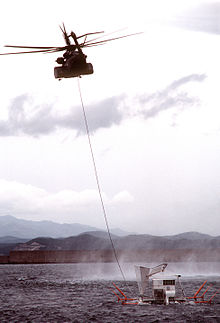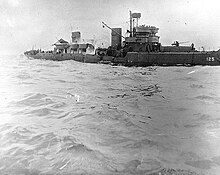40:
204:
191:
after two weeks but have the ship-counter mechanism set to ignore the first two trigger events, and still others in the same minefield (with the magnetic and pressure sensors enabled) may not become armed until three weeks have passed. Groups of mines within this mine-field may have different target signatures which may or may not overlap. The fuzes on influence mines allow many different permutations, which complicates the clearance process.
150:, that are streamed from the sweeping vessel thus keeping the sweep at a determined depth and position. Some large warships were routinely equipped with paravane sweeps near the bows in case they inadvertently sailed into minefields—the mine would be deflected towards the paravane by the wire instead of towards the ship by its wake. More recently, heavy-lift helicopters have dragged minesweeping sleds, as in the 1991 Persian Gulf War.
56:
176:
typical pressure displacement of such a vessel. As a result, a mine-sweeper must accurately guess and mimic the required target signature to trigger detonation. The task is complicated by the fact that an influence mine may have one or more of a hundred different potential target signatures programmed into it.
190:
When influence mines are laid in an ocean minefield, they may have various combinations of fuze settings configured. For example, some mines (with the acoustic sensor enabled) may become active within three hours of being laid, others (with the acoustic and magnetic sensors enabled) may become active
175:
Modern influence mines are designed to discriminate against false inputs and are much more difficult to sweep. They often contain inherent anti-sweeping mechanisms. For example, they may be programmed to respond to the unique noise of a particular ship-type, its associated magnetic signature and the
122:
If a contact sweep hits a mine, the wire of the sweep rubs against the mooring wire until it is cut. Sometimes "cutters", explosive devices to cut the mine's wire, are used to lessen the strain on the sweeping wire. Mines cut free are recorded and collected for research or shot with a deck gun.
194:
Mines with ship-counters, arming delays, and highly specific target signatures in mine fuses can falsely convince a belligerent that a particular area is clear of mines or has been swept effectively because a succession of vessels have already passed through safely.
102:
A sweep is either a contact sweep, a wire dragged through the water by one or two ships to cut the mooring wire of floating mines, or a distance sweep that mimics a ship to detonate the mines. The sweeps are dragged by
85:
using various measures to either capture or detonate the mines, but sometimes also with an aircraft made for that purpose. Minesweeping has been practiced since the advent of naval mining in 1855 during the
111:. Each run covers between 100 and 200 meters (330 and 660 ft), and the ships must move slowly in a straight line, making them vulnerable to enemy fire. This was exploited by the Turkish army in the
230:. The "Directional Wireless Installation" (DWI), a cover story for the true purpose of the magnetic loop, was used successfully on 10 May 1940, to sweep a path for the escape of the
187:) after a pre-set time. During the pre-set arming delay (which could be days or weeks) the mine would remain dormant and ignore any target stimulus, whether genuine or faked.
183:
has been triggered a pre-set number of times. To further complicate matters, influence mines may be programmed to arm themselves (or disarm automatically—known as
246:. Their use revealed the limitations of the technique, in that it only works effectively in very shallow water (such as canals and harbours). From about 1943,
406:
271:
to tow several types of mine hunting or mine sweeping gear through the water. It replaced the earlier, RH-53A and RH-53D variants of the
153:
The distance sweep mimics the sound and magnetism of a ship and is pulled behind the sweeper. It has floating coils and large underwater
329:
179:
Another anti-sweeping mechanism is a ship-counter in the mine fuze. When enabled, this allows detonation only after the mine
235:
359:
414:
17:
475:
442:
272:
253:
231:
481:
135:
invented "mine protectors" to break a sweeping wire before it could cut the mine's mooring wire.
276:
257:
139:
132:
146:
instead of a second minesweeper. These are torpedo-shaped towed bodies, similar in shape to a
499:
264:
208:
128:
44:
504:
284:
227:
8:
215:
Aircraft can also be used for minesweeping. During the Second World War, fifteen
British
165:
112:
268:
216:
169:
108:
104:
337:
384:
143:
90:. The first minesweepers date to that war and consisted of British rowboats trailing
60:
119:
batteries prevented the
British and French from clearing a path through minefields.
172:
bombers
Wellington DW.Mk I fitted with degaussing coils to trigger magnetic mines.
161:
474:
124:
39:
223:
147:
91:
275:. Other examples of minesweeping helicopters include the RH-3A variant of the
493:
250:
51:
tows a minesweeping sled while conducting simulated mine clearing operations.
247:
385:"Paravane - Definition and More from the Free Merriam-Webster Dictionary"
87:
82:
296:
243:
239:
78:
70:, 7 June 1944. Note her broken back, with smoke pouring from amidships.
67:
280:
203:
116:
55:
31:
219:
48:
459:
Slide 34 of 81. Hosted by
Federation of American Scientists.
211:
of the United States Navy towing an MK105 mine sweeping sled
180:
260:
tri-motor flying boats were also used for this purpose.
157:. It is the only sweep effective against bottom mines.
234:
to the UK. The DWI was used most successfully in the
449:. Surface Warfare Officers School Command, U.S. Navy
107:, either purpose-built military ships or converted
485:. Vol. 31 (12th ed.). pp. 949–995.
491:
81:, usually by a specially designed ship called a
407:"Britain's Vickers Wellington bomber, 'Wimpey'"
436:
434:
432:
411:World War II Vehicles, Tanks, and Airplanes
27:Practice of removing explosive naval mines
429:
279:, as well as the Mi-14BT variant of the
202:
138:Minesweepers protect themselves with an
54:
38:
440:
14:
492:
443:"Mine Counter-Counter Measures (MCCM)"
77:is the practice of removing explosive
472:
447:Mine Warfare Introduction: The Threat
267:helicopter is used primarily by the
476:"Minesweeping and Minelaying"
30:For the removal of land mines, see
24:
413:. Wwiivehicles.com. Archived from
25:
516:
466:
283:and the MCH-101 variant of the
222:were modified to carry a large
441:Garrold, Tim (December 1998).
399:
377:
352:
336:. Charles Lees. Archived from
322:
309:
198:
13:
1:
302:
7:
290:
273:Sikorsky CH-53 Sea Stallion
10:
521:
330:"Mine Sweeping Operations"
258:Blohm & Voss BV 138 MS
256:were similarly converted.
97:
66:after striking a mine off
29:
238:, particularly over the
482:Encyclopædia Britannica
473:Dewar, Alfred (1922).
277:Sikorsky SH-3 Sea King
212:
71:
52:
387:. Merriam-webster.com
236:Mediterranean Theatre
206:
129:Imperial Russian Navy
115:in 1915, when mobile
58:
42:
285:AgustaWestland AW101
228:electrical generator
417:on 18 November 2011
364:encyclopedia.mil.ru
317:Mine Warfare at Sea
166:RAF Coastal Command
113:Battle of Gallipoli
94:to snag the mines.
269:United States Navy
244:Alexandria Harbour
232:Dutch royal family
224:magnetic induction
217:Vickers Wellington
213:
185:self-sterilization
170:Vickers Wellington
72:
53:
360:"Минный защитник"
315:Howard S. Levie,
265:MH-53E Sea Dragon
16:(Redirected from
512:
486:
478:
460:
458:
456:
454:
438:
427:
426:
424:
422:
403:
397:
396:
394:
392:
381:
375:
374:
372:
370:
356:
350:
349:
347:
345:
326:
320:
313:
162:Second World War
21:
520:
519:
515:
514:
513:
511:
510:
509:
490:
489:
469:
464:
463:
452:
450:
439:
430:
420:
418:
405:
404:
400:
390:
388:
383:
382:
378:
368:
366:
358:
357:
353:
343:
341:
340:on 2 April 2009
328:
327:
323:
319:(1992), p. 119.
314:
310:
305:
293:
201:
125:First World War
100:
35:
28:
23:
22:
15:
12:
11:
5:
518:
508:
507:
502:
488:
487:
468:
467:External links
465:
462:
461:
428:
398:
376:
351:
321:
307:
306:
304:
301:
300:
299:
292:
289:
200:
197:
148:Harvey Torpedo
99:
96:
26:
9:
6:
4:
3:
2:
517:
506:
503:
501:
498:
497:
495:
484:
483:
477:
471:
470:
448:
444:
437:
435:
433:
416:
412:
408:
402:
386:
380:
365:
361:
355:
339:
335:
331:
325:
318:
312:
308:
298:
295:
294:
288:
286:
282:
278:
274:
270:
266:
261:
259:
255:
252:
251:Junkers Ju 52
249:
245:
241:
237:
233:
229:
225:
221:
218:
210:
205:
196:
192:
188:
186:
182:
177:
173:
171:
167:
163:
158:
156:
151:
149:
145:
141:
136:
134:
130:
126:
120:
118:
114:
110:
106:
95:
93:
89:
84:
80:
76:
69:
65:
64:
57:
50:
46:
41:
37:
33:
19:
18:Mine sweeping
500:Mine warfare
480:
451:. Retrieved
446:
419:. Retrieved
415:the original
410:
401:
389:. Retrieved
379:
367:. Retrieved
363:
354:
342:. Retrieved
338:the original
334:Minesweeping
333:
324:
316:
311:
262:
226:loop and an
214:
193:
189:
184:
178:
174:
159:
154:
152:
137:
133:Pyotr Kitkin
121:
105:minesweepers
101:
75:Minesweeping
74:
73:
62:
59:Minesweeper
36:
505:Mine action
453:31 December
421:31 December
391:31 December
344:31 December
199:By aircraft
160:During the
123:Before the
88:Crimean War
83:minesweeper
79:naval mines
494:Categories
303:References
297:Minehunter
254:transports
240:Suez Canal
68:Utah Beach
281:Mil Mi-14
61:USS
369:12 March
291:See also
144:paravane
131:officer
117:howitzer
109:trawlers
92:grapnels
32:demining
220:bombers
140:oropesa
98:By ship
248:German
209:MH-53E
127:, the
45:MH-53E
168:used
155:drums
49:HM-15
47:from
455:2011
423:2011
393:2011
371:2019
346:2011
263:The
242:and
181:fuze
63:Tide
207:An
142:or
43:An
496::
479:.
445:.
431:^
409:.
362:.
332:.
287:.
164:,
457:.
425:.
395:.
373:.
348:.
34:.
20:)
Text is available under the Creative Commons Attribution-ShareAlike License. Additional terms may apply.


